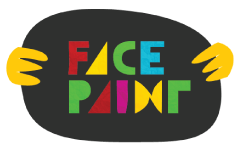I recently read a comment by a new face painter which expressed her discontent at copying other artists’ designs and not being able to come up with new face painting art on her own. I knew exactly how she felt.
When I began face painting in 2013, I was awed by the amazing work of so many talented face painters, such as Lisa Joy Young, Ashlea Henson, Heather Green, and the Wolfe brothers. Their colors were vibrant. Their lines were clean and sure. They made it look effortless.
Of course, it was anything but effortless. In reality, face painting was a ton of work, but that didn’t change my desire to somehow come up with my own designs, too.
It wasn’t until I was well into my second year of face painting that I saw the first glimmer of positive results when it came to my attempts at face painting design. Instead of copying other artists every time, I began to incorporate some of my ideas. Good composition choices trickled into my own work as I studied the work of master face painters, and I was happier with what how my own face painting designs turned out.
What helped me the most, however, is that I finally figured out that in order to become a better designer, I would have to take risks and let myself fail. A lot.
Unfortunately, this realization did not suddenly make me a wildly successful designer. But in allowing myself to fail, I granted myself permission to make mistakes that would help me learn. Lots of failures were going to be necessary if I were ever to come up with the good stuff down the road.
Artists have varying goals when it comes to business and artistry. They are scattered on a lengthy journey to what they believe constitutes success. As you travel on your own artist’s journey, it’s better if you understand from the beginning that you are going to discard a lot of art you don’t like as you move forward. You’ll keep a few favorites (at least until they’re replaced by those you like better), but the most important thing is that you never become so afraid of the next step on the road that you can’t move forward at all.
When it comes to design (or anything else in life), it turns out that failure is only a bad thing if you allow it to become your destination. Failure as a step on a journey isn’t bad at all. It does have a little sting, because no one likes to fail, but if you hang in there, the blossoming roses will makeup for the pricks caused by thorns. In the end, failure is just a side effect of hard work and perseverance, and if you don’t let it hinder your forward progress, you’ll get where you want to go eventually.
On a side note, I’m still happily creating plenty of design failures. My guess is that those artists I consider master painters probably are, too. And I still enjoy, copy, and practice designs by other face painters whose work I love. (One of my most-requested designs comes from one of the Wolfe brothers’ books. It will probably always be in my idea book for parties.) Little by little, elements from the work of other artists have continued to seep in and influence my face painting for the better. That’s a good thing. As we observe and attempt designs by artists, it makes us stronger and better. It’s good to learn from each other.
Beth MacKinney is the owner of and primary face painter for Face Paint Pizzazz in the NW Chicago suburbs. Stop by Clownantics.com to see other face painting tutorials by Beth. If you’re on Facebook, join the Facepaint.com Challenge Group to showcase your artwork and have a chance to win a store credit for each week’s theme.





